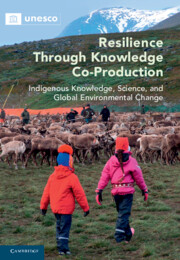 Resilience through Knowledge Co-Production
Resilience through Knowledge Co-Production Book contents
- Resilience through Knowledge Co-production
- Resilience through Knowledge Co-production
- Copyright page
- Contents
- Contributors
- Acknowledgements
- Introduction
- Part I From Practice to Principles
- Part II Indigenous Perspectives on Environmental Change
- Part III Global Change and Indigenous Responses
- 12 Competing Paradigms of Himalayan Climate Change and Adaptations: Indigenous Knowledge versus Economics
- 13 Coping with a Warming Winter Climate in Arctic Russia: Patterns of Extreme Weather Affecting Nenets Reindeer Nomadism
- 14 Rising Above the Flood: Modifications in Agricultural Practices and Livelihood Systems in Central Amazonia – Perspectives from Ribeirinho and Indigenous Communities
- 15 Indigenous Storytelling and Climate Change Adaptation
- 16 Indigenous Knowledge and the Coloniality of Reality: Climate Change Otherwise in the Bolivian Andes
- Epilogue
- Index
- References
13 - Coping with a Warming Winter Climate in Arctic Russia: Patterns of Extreme Weather Affecting Nenets Reindeer Nomadism
from Part III - Global Change and Indigenous Responses
Published online by Cambridge University Press: 02 June 2022
- Resilience through Knowledge Co-production
- Resilience through Knowledge Co-production
- Copyright page
- Contents
- Contributors
- Acknowledgements
- Introduction
- Part I From Practice to Principles
- Part II Indigenous Perspectives on Environmental Change
- Part III Global Change and Indigenous Responses
- 12 Competing Paradigms of Himalayan Climate Change and Adaptations: Indigenous Knowledge versus Economics
- 13 Coping with a Warming Winter Climate in Arctic Russia: Patterns of Extreme Weather Affecting Nenets Reindeer Nomadism
- 14 Rising Above the Flood: Modifications in Agricultural Practices and Livelihood Systems in Central Amazonia – Perspectives from Ribeirinho and Indigenous Communities
- 15 Indigenous Storytelling and Climate Change Adaptation
- 16 Indigenous Knowledge and the Coloniality of Reality: Climate Change Otherwise in the Bolivian Andes
- Epilogue
- Index
- References
Summary
Assessing potential drivers of and linkages between sea ice retreat or thinning across Arctic Russia and maintenance of the ancient and unique social-ecological systems of the Indigenous reindeer-herding Nenets is a pressing task. Sea ice loss is accelerating in the Barents and Kara Seas in the northwestern region of Arctic Russia. Warming summer air temperatures in recent decades have been linked to more frequent and sustained summer high-pressure systems over West Siberia but not to sea ice retreat. At the same time, autumn/winter rain-on-snow events across the region have become more frequent and intense. Two major rain-on-snow events during November 2006 and 2013 led to massive winter reindeer mortality episodes on Yamal Peninsula, where tundra nomadism remains a vitally important livelihood activity for the indigenous Nenets.
Here we review evidence for autumn atmospheric warming and precipitation increases over Arctic coastal lands in proximity to Barents and Kara sea ice loss. Realizing mutual coexistence of tundra nomadism within the Arctic’s largest natural gas complex under a warming climate will require ready access to and careful interpretation of real-time meteorological and sea-ice data and modelling, as well as meaningful consultation with local communities.
Keywords
- Type
- Chapter
- Information
- Resilience through Knowledge Co-ProductionIndigenous Knowledge, Science, and Global Environmental Change, pp. 217 - 232Publisher: Cambridge University PressPrint publication year: 2022
References
- 2
- Cited by


